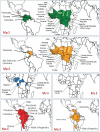Mansonellosis: current perspectives
- PMID: 30050351
- PMCID: PMC6047625
- DOI: 10.2147/RRTM.S125750
Mansonellosis: current perspectives
Abstract
Mansonellosis is a filarial disease caused by three species of filarial (nematode) parasites (Mansonella perstans, Mansonella streptocerca, and Mansonella ozzardi) that use humans as their main definitive hosts. These parasites are transmitted from person to person by bloodsucking females from two families of flies (Diptera). Biting midges (Ceratopogonidae) transmit all three species of Mansonella, but blackflies (Simuliidae) are also known to play a role in the transmission of M. ozzardi in parts of Latin America. M. perstans and M. streptocerca are endemic in western, eastern, and central Africa, and M. perstans is also present in the neotropical region from equatorial Brazil to the Caribbean coast. M. ozzardi has a patchy distribution in Latin America and the Caribbean. Mansonellosis infections are thought to have little pathogenicity and to be almost always asymptomatic, but occasionally causing itching, joint pains, enlarged lymph glands, and vague abdominal symptoms. In Brazil, M. ozzardi infections are also associated with corneal lesions. Diagnosis is usually performed by detecting microfilariae in peripheral blood or skin without any periodicity. There is no standard treatment at present for mansonellosis. The combination therapy of diethylcarbamazine plus mebendazole for M. perstans microfilaremia is presently one of the most widely used, but the use of ivermectin has also been proven to be very effective against microfilariae. Recently, doxycycline has shown excellent efficacy and safety when used as an antimicrobial against endosymbiotic Wolbachia bacteria harbored by some strains of M. perstans and M. ozzardi. Diethylcarbamazine and ivermectin have been used effectively to treat M. streptocerca infection. There are at present no estimates of the disease burden caused by mansonellosis, and thus its importance to many global health professionals and policy makers is presently limited to how it can interfere with diagnostic tools used in modern filarial disease control and elimination programs aimed at other species of filariae.
Keywords: M. ozzardi; M. perstans; M. streptocerca; filariasis; mansonellosis; neglected disease.
Conflict of interest statement
Disclosure The authors report no conflicts of interest in this work.
Figures



References
-
- Bain O, Mutafchiev Y, Junker K, et al. Review of the genus Mansonella Faust, 1929 sensu lato (Nematoda: Onchocercidae), with descriptions of a new subgenus and a new subspecies. Zootaxa. 2015;3918(2):151–193. - PubMed
-
- Medeiros JF, Crainey JL, Pessoa FA, Luz SL. Mansonelliasis. In: Marcondes CB, editor. Arthropod Borne Diseases. Heidelberg: Springer; 2017. pp. 405–426.
-
- Nutman TB. Filarial infections. In: Cohen J, Powderly WG, Opal SM, editors. Infectious Diseases. Amsterdam: Elsevier; 2016. pp. 1046–1052.
Publication types
LinkOut - more resources
Full Text Sources
Other Literature Sources

